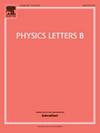Ensuring that toponium is glued, not nailed
IF 4.3
2区 物理与天体物理
Q1 ASTRONOMY & ASTROPHYSICS
引用次数: 0
Abstract
Hints of toponium might be incipient in LHC data, as given the vast numbers of t quarks produced, some survive on the exponential-decay tail long enough to fasten together. I here discuss a few differences between the standard Quantum Chromodynamics (QCD) binding (the “glue”) and exotic short-range binding (the “nail”). If the binding energy below threshold reaches the 3 GeV range the peak of the is distinct enough that a cross-section dip should be apparent in the line shape, should there only be one isolated resonance, but is filled by the excited QCD states adding about a pbarn to the cross section of production. Their effect for smaller binding energies is a tenuous increase in the cross section. A new-physics short-range interaction, on the other hand, yields a larger cross-section for equal binding energy (or hardly a visible bound state for similar cross section). This is due to its larger relative wavefunction at small distances. Finally, assuming that standard QCD plays out, I comment on what size of constraints on new-physics coefficients one can expect at given precision.
确保toponium是粘上去的,而不是钉上去的
在大型强子对撞机的数据中,toponium的迹象可能刚刚出现,因为产生了大量的t夸克,一些夸克在指数衰变尾巴上存活了足够长的时间,将它们固定在一起。我在这里讨论标准量子色动力学(QCD)结合(“胶水”)和奇异短程结合(“钉子”)之间的一些区别。如果低于阈值的束缚能达到3gev范围,则ηt的峰值足够明显,在线形上应该有一个明显的截面下降,如果只有一个孤立共振,但被激发的QCD态填充,使tt¯产生的截面增加了约一个pbarn。它们对较小结合能的影响是截面的微弱增加。另一方面,一个新物理的短程相互作用,在相同的结合能下产生更大的横截面(或者在相似的横截面下几乎看不到束缚态)。这是由于它在小距离处的相对波函数较大。最后,假设标准QCD发挥作用,我评论了在给定精度下,人们可以期望的新物理系数的约束大小。
本文章由计算机程序翻译,如有差异,请以英文原文为准。
求助全文
约1分钟内获得全文
求助全文
来源期刊

Physics Letters B
物理-物理:综合
CiteScore
9.10
自引率
6.80%
发文量
647
审稿时长
3 months
期刊介绍:
Physics Letters B ensures the rapid publication of important new results in particle physics, nuclear physics and cosmology. Specialized editors are responsible for contributions in experimental nuclear physics, theoretical nuclear physics, experimental high-energy physics, theoretical high-energy physics, and astrophysics.
 求助内容:
求助内容: 应助结果提醒方式:
应助结果提醒方式:


